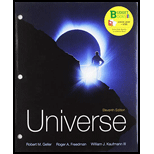
(a)
The tidal force that Earth exerts on
(a)
Answer to Problem 22Q
Solution:
Explanation of Solution
Given data:
The mass of the rock present on the Moon is
The Moon is at perigee position from Earth.
Formula used:
The tidal force that Earth exerts on the Moon is expressed as:
Here,
Explanation:
Recall the expression for the tidal force that Earth exerts on the rock present on the Moon when it is at perigee:
Substitute
Conclusion:
Hence, the tidal force experienced by
(b)
The tidal force experienced by a
(b)
Answer to Problem 22Q
Solution:
Explanation of Solution
Given data:
The mass of the rock present on the Moon is
The Moon is at apogee position from Earth.
Formula used:
The tidal force that Earth exerts on the Moon is expressed as:
Here,
Explanation:
Recall the expression for the tidal force that Earth exerts on the rock present on the Moon when it is at apogee:
Substitute
Conclusion:
Hence, the tidal force experienced by a
(c)
The ratio of the tidal forces experienced by a
(c)
Answer to Problem 22Q
Solution:
Explanation of Solution
Introduction:
The Moon and Earth, both exerts tidal forces, which are pulling in nature and are the direct results of the gravitational forces exerted by them on each other. This force is inversely proportional to the cube of the distance between the centers of Earth and Moon.
Due to the tidal force by the Moon on Earth, tidal waves are generated whereas the Moon recedes away from Earth due to the tidal force of Earth.
Explanation:
The ratio of tidal force experienced by the
Refer to the sub-parts (a) and (b) of the problem and substitute
Conclusion:
Hence, the rock on the Moon experiences around
Want to see more full solutions like this?
Chapter 10 Solutions
Universe - Text Only (Looseleaf)
- During a retrograde loop of Mars, would you expect Mars to be brighter than usual in the sky, about average in brightness, or fainter than usual in the sky? Explain.arrow_forwardHow long does the eastward wind at the equator of Saturn take to circle the planet once at a speed of 500 m/s? Compare this value with the rotation period of the planet. (Note: Necessary data are given in Celestial Profile: Saturn.)arrow_forwardWhat is the smallest-diameter crater you can identify in the photo of Mercury in Figure 2 of the Concept Art: Terrestrial and Jovian Planets? (Hint: See Appendix Table A-10, Properties of the Planets, to find the radius of Mercury in kilometers for scale.)arrow_forward
- Why do you think the outer planets have such extensive systems of rings and moons, while the inner planets do not?arrow_forwardPhobos obits Mars at a distance of 9376 km from the center of the planet and has a period of 0.3 189 days. Assume Phobos’s orbit is circular. Calculate the mass of Mars. (Hints: Use the circular orbit velocity formula in Reasoning with Numbers 4-1; make sure to convert relevant quantities to units of meters, kilograms. and seconds.)arrow_forwardOne planet is three times farther from the Sun than another. Will the farther planet take more, less, or the same amount of time to orbit the Sun? Will the closer planet orbit slower, faster, or the same speed? How much longer will the farther planet take to orbit than the closer planet? If the closer planet is located at 10 AU, how far is the farther planet, and what are the two planet's names?arrow_forward
 Foundations of Astronomy (MindTap Course List)PhysicsISBN:9781337399920Author:Michael A. Seeds, Dana BackmanPublisher:Cengage Learning
Foundations of Astronomy (MindTap Course List)PhysicsISBN:9781337399920Author:Michael A. Seeds, Dana BackmanPublisher:Cengage Learning
 Stars and Galaxies (MindTap Course List)PhysicsISBN:9781337399944Author:Michael A. SeedsPublisher:Cengage Learning
Stars and Galaxies (MindTap Course List)PhysicsISBN:9781337399944Author:Michael A. SeedsPublisher:Cengage Learning
 AstronomyPhysicsISBN:9781938168284Author:Andrew Fraknoi; David Morrison; Sidney C. WolffPublisher:OpenStax
AstronomyPhysicsISBN:9781938168284Author:Andrew Fraknoi; David Morrison; Sidney C. WolffPublisher:OpenStax Horizons: Exploring the Universe (MindTap Course ...PhysicsISBN:9781305960961Author:Michael A. Seeds, Dana BackmanPublisher:Cengage Learning
Horizons: Exploring the Universe (MindTap Course ...PhysicsISBN:9781305960961Author:Michael A. Seeds, Dana BackmanPublisher:Cengage Learning





